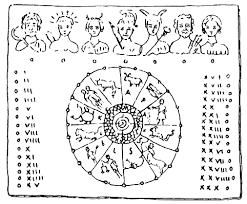Kalendarz Rzymski

Twórcą kalendarza rzymskiego był legendarny założyciel Rzymu — Romulus (VIII w. p.n.e.). Podstawą był rok naturalny, oparty na obserwacjach niektórych zjawisk w świecie zwierzęcym i roślinnym. Składał się z 10 miesięcy. Sześć z nich miało po 30, a cztery — po 31 dni. Rok rzymski — Romulusowy — liczył więc tylko 304 dni. Zaczynał się 1 III. Układ zaś miesięcy był następujący:
Martius — marzec — poświęcony bogu wojny, Marsowi, „ojcu” Romulusa
Aprilis — kwiecień — poświęcony Wenus (Afrodycie)
Maius — maj — miesiąc Mai, bogini utożsamianej z Bona Dea
Iunius — czerwiec — miesiąc Junony
Quinctilis — lipiec — piąty z kolei
Sextilis — sierpień — szósty
Semptember — wrzesień — siódmy
October — październik — ósmy
November — listopad — dziewiąty
December — grudzień — dziesiąty
Taki kalendarz nie mógł oczywiście długo się utrzymać. Toteż — z chwilą osiągnięcia wyższego stopnia rozwoju cywilizacyjnego — wprowadzono kalendarz księżycowy z miesiącem jako najważniejszą jednostką rachuby czasu. Kiedy się to stało — nie wiadomo. Rzymianie twierdzili, że dzieła tego dokonał następca Romulusa — Numa Pompiliusz. Inni — że sam bóg Janus, stworzyciel Nieba i Ziemi, ojciec wszystkich innych bogów i ludzi, zarazem bóg czasu (notabene — jedyny rodzimy bóg rzymski w panteonie bóstw importowanych z Grecji). Tak czy inaczej — była to ważna reforma.
Rok Numy (lub Janusa) składał się z 12 miesięcy. Cztery z nich (III, V, VII i X) miały po 31 dni, siedem miesięcy (IV, VI, VIII, IX, XII i I) po 29, jeden miesiąc (II) — 28. Rok rzymski, według tego kalendarza, liczył więc już 355 dni.
Oczywiście daleko mu było do zgodności z rokiem słonecznym. Aby zaradzić tej rozbieżności — wprowadzono w V w. p.n.e. lata przestępne, z miesiącami dodatkowymi liczącymi po 22 lub 23 dni (tzw. mercedonius), a wstawianymi co drugi rok po święcie terminariów lutowych, tzn. między 23 a 24 lutego. Miesiące te występowały w cyklu 4-letnim, w którym 2 lata były zwyczajne, liczące po 355 dni, i 2 lata przestępne: jeden — liczący 377 dni (355 + 22), drugi — 378 (355 + 23). Kolejność lat w cyklu była następująca: 355 + 377 + 355 + 378. Łączna liczba dni wynosiła więc w cyklu 1465, przeciętna zaś długość roku 366,25 dnia.
Jak z tego wynika, Rzymianie przesadzili. Nic zresztą dziwnego: w astronomii i matematyce nie byli mocni. Prawdopodobnie nie znali jeszcze prawdziwej długości roku słonecznego.
Dodane 2 miesiące nosiły nazwy: Ianuarius i Februarius. Wstawiono je do kalendarza nie po miesiącu dziesiątym — Decembrze — lecz na początku, a więc przed marcem, poświęconym Marsowi. Ianuarius był miesiącem Janusa. Otwierał on teraz nie tylko rzymski rok, ale również każdy miesiąc, a nawet dzień. Niestety nie był to kalendarz doskonały. Pieczę nad nim sprawowali kapłani. Ustawa Maniusa Aciliusa Glabriona z 191 r. p.n.e. nakładała na nich obowiązek prawidłowego ustanawiania lat przestępnych. Rzadko jednak się z niego wywiązywali. W rezultacie w kalendarzu zapanował chaos. Kres temu położyła dopiero reforma Juliusa Cezara, wprowadzająca nowy kalendarz oparty na słonecznej rachubie czasu.
A od kiedy liczono lata?
W republikańskim Rzymie utrzymywał się system określania roku według nazwisk obu konsulów, a więc podobnie jak w Atenach (według archonta) i w Sparcie (efora). Pisano np. „za konsulatu Marka Messali i Marka Pizona”. Punktem wyjściowym była data założenia Rzymu, ale ustalenie jej nastręczało wiele kłopotów. Dokonał tego dopiero rzymski encyklopedysta, Marcus Terentius Varro z Reate (116—27/26 p.n.e.). Przyjął on rok 753 p.n.e. (według naszych przeliczeń) jako rok założenia Rzymu. Datę tę uznano powszechnie za początek rzymskiej ery, ale… tylko w chronologii historycznej i literackiej. Pisano: ab urbe condita — od założenia miasta. Czasem obowiązywał też system datowania od… wypędzenia królów z Rzymu, co — według historyków rzymskich — zdarzyło się ok. 510 r. p.n.e. Na co dzień — w urzędowej i prywatnej chronologii — datowano po staremu: według nazwisk urzędujących konsulów lub lat panowania władców.
